The Economics and Statistics Division maintains archives of previous publications for accountability purposes, but makes no updates to keep these documents current with the latest data revisions from Statistics Canada. As a result, information in older documents may not be accurate. Please exercise caution when referring to older documents. For the latest information and historical data, please contact the individual listed to the right.
<--- Return to Archive
For additional information relating to this article, please contact:
February 25, 2022CAPITAL AND REPAIR EXPENDITURES SURVEY, 2021 (PRELIMINARY) AND 2022 (INTENTIONS) Statistics Canada has released preliminary estimates for 2021 and intentions for 2022 from the annual survey of capital expenditures for non-residential construction and machinery and equipment. The Capital and Repair Expenditures Survey is based on a sample survey of 27,000 private and public organizations. The survey on intentions for 2022 was conducted from September 2021 to January 2022.
Preliminary estimates on Nova Scotia's capital expenditures for 2021 were revised up to $4,339.2 million, a gain of 12.1% (+$468.1 million) compared to 2020.
Capital expenditures include both new capital construction and machinery and equipment spending. Capital construction in 2021 for Nova Scotia increased 21.6% to $2,733.7 million. Private construction rose 17.9% and public construction increased 24.1% over 2020. Machinery and equipment was down 1.1% to $1,605.5 million in 2021, with declines in public investment (-8.2%, -28.8 million) slightly offset by a rise in private investment (+0.5%, +$7.1 million).
Capital expenditure intentions for 2022 are for an increase of 10.5% (+454.7 million) to $4,793.9 million. Compared to 2021, private construction (-1.4%, -$15.3 million) is expected to lower while private machinery and equipment spending (+7.8%, +$103.1 million) is expected to rise. Public capital construction is expected to continue through 2022 with capital construction increasing 20.4% (+338.7 million) from 2021. In 2022, intentions for public machinery and equipment spending are expected to increase (+10.2%, +$28.2 million).
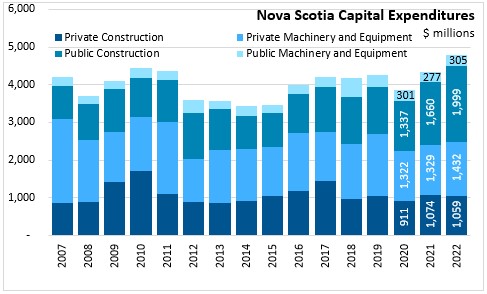
Repair expenditures decreased 17.7% in 2020, down from a 7.8% gain in 2019. Repair expenditures decreased for structures (-16.6%) and machinery and equipment (-18.9%). Repair expenditures decreased more in the private sector (-23.3%) than for the public sector (-5.7%) in 2020.
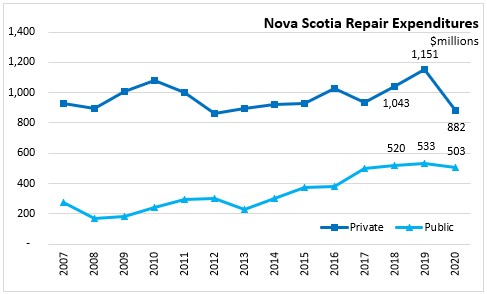
On an industry basis for Nova Scotia, the $468.2 million increase in capital expenditures for 2021 was due largely to increases in:
- agriculture, forestry, fishing and hunting (+$36 million),
- construction (+$21 million),
- utilities (+$162 million),
- mining, quarrying, and oil and gas extraction (+$21 million),
- wholesale trade (+$73 million),
- information and cultural industries (+$23 million),
- educational services (+$152 million),
- health care and social assistance (+$58 million),
- arts, entertainment and recreation (+$55 million),
- administrative and support, waste management and remediation services (+$40 million),
while notable decreases in capital expenditures occurred for:
- transportation/warehousing (-$11 million),
- real estate/rental (-$8 million),
- manufacturing (-$8 million),
- retail trade (-$6 million).
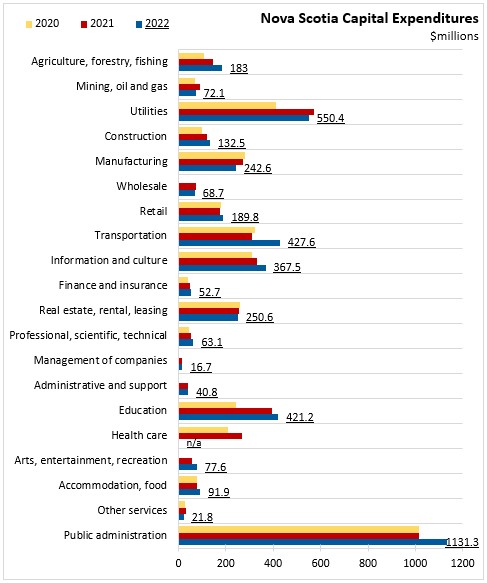
For 2022, total capital expenditures are expected to increase by 10.5% or $455 million for Nova Scotia, with notable increases for:
- agriculture, forestry, fishing and hunting (+$38 million),
- transportation/warehousing (+$116 million),
- information and cultural industries (+$36 million),
- education services (+$25 million),
- arts, entertainment and recreation (+$23 million),
- public administration (+$118 million),
and notable decreases in capital expenditures for:
- health care (-$267 million),
- manufacturing (-$30 million),
- utilities (-$23 million),
- mining, quarrying and oil and gas extraction (-$18 million).
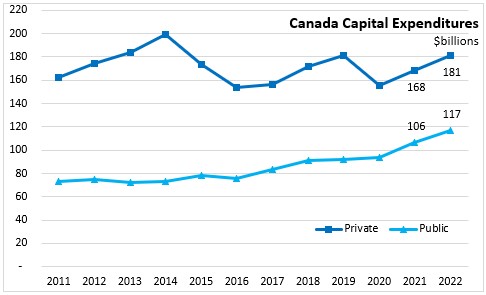
Canada is expected to see an increase of 8.6% in capital expenditures in 2022 following an increase of 10.4% in 2021. Growth in capital expenditures is led by both public and private capital investment in 2022. Elevated investment from the public sector is expected to continue in 2022. The public sector’s share of capital spending increased from one-third (pre-pandemic years) to close to two-fifths in 2021 and 2022. Investment by private sector organizations increased 8.4% in 2021 following a 14.5% decline in 2020 and expected to increase 7.8% in 2022. Clean energy major projects are contributing to increase in capital spending.
Ontario (+12.2%), Nova Scotia (+12.1%), and Prince Edward Island (+11.9) reported the largest gain in capital spending in 2021. For 2022, increased investment in non-residential construction and machinery and equipment is expected to increase in all provinces except Newfoundland and Labrador (-0.4%), with the largest increases in Saskatchewan (+18.5%) and Quebec (+11.8%).
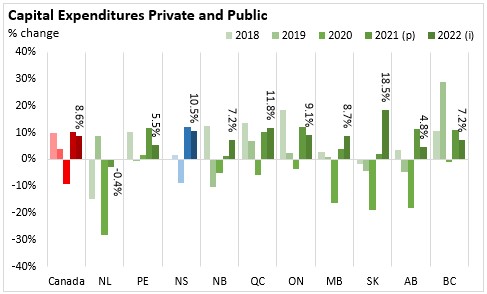
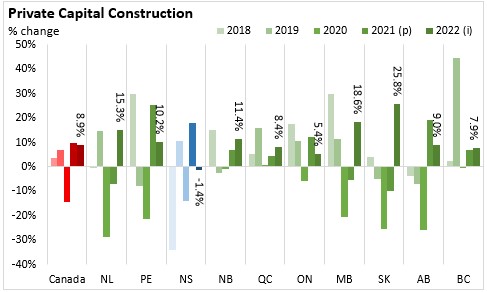
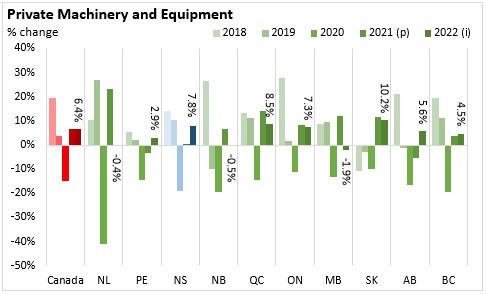
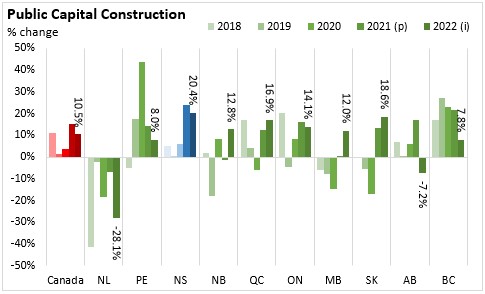
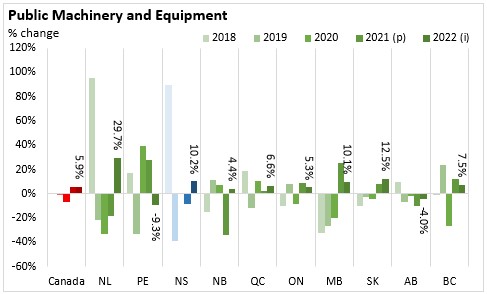
In 2020, investment in software declined 10.3% across Canada, with the largest percentage decreases in Nova Scotia (-21.9%), Ontario (-14.6%) and Prince Edward Island (-11.6%). In Nova Scotia, investment in software decreased 21.9% to $177.9 million.
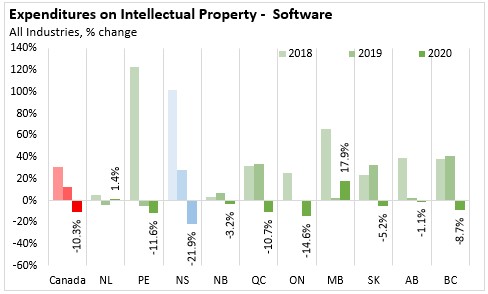
Non-residential capital and repair expenditures, 2021 (intentions)
Non-residential capital and repair expenditures, 2020 (revised intentions)
<--- Return to Archive